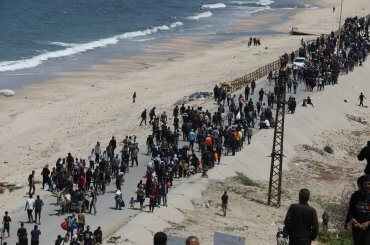
Predator B Drone (U.S. Customs and Border Protection: 2010)
Drones over Iran seemed bad enough, but drones over a family farm in North Dakota? Because of six purloined cows?
That’s the stunning story broken by the Los Angeles Times Sunday: in the plain states as elsewhere, local police forces have taken to calling in the drones, turning these creepy neo-spying craft on United States citizens living on United States soil.
The LA Times story focuses on the case of the Brossarts, a family of extremist anti-government farmers in Nelson County, North Dakota, who stole six cows worth $6000 and, after hustling a prying sheriff from their property with shotguns, wound up with an unmanned Predator B drone circling their gun-toting, heat-emitting selves. To be sure, the Brossarts do not subscribe to a warm and fuzzy belief system. As members of the Sovereign Citizen Movement, their particular brand of anarcho-wingnuttery involves an elaborate set of concentric anti-government conspiracies theories, initially rooted in white supremacy and anti-Semitism, that occasionally leads to deadly shoot-outs with law enforcement but mostly takes the form of irritating but harmless “paper terrorism.”
But how any of this justifies sending a drone to surveil them — the same hunter-killer drone that has been employed to such deadly and disturbing effect in Afghanistan — remains utterly confounding.
And yet. As the LA Times Brian Bennett writes, local law enforcers, from small town sheriffs to former big-city police chiefs like Howard Safir, seem to have no problem calling in the drones:
Local police say they have used two unarmed Predators based at Grand Forks Air Force Base to fly at least two dozen surveillance flights since June. The FBI and Drug Enforcement Administration have used Predators for other domestic investigations, officials said.
“We don’t use [drones] on every call out,” said Bill Macki, head of the police SWAT team in Grand Forks. “If we have something in town like an apartment complex, we don’t call them.”
The drones belong to U.S. Customs and Border Protection, which operates eight Predators on the country’s northern and southwestern borders to search for illegal immigrants and smugglers. The previously unreported use of its drones to assist local, state and federal law enforcement has occurred without any public acknowledgment or debate.
Congress first authorized Customs and Border Protection to buy unarmed Predators in 2005. Officials in charge of the fleet cite broad authority to work with police from budget requests to Congress that cite “interior law enforcement support” as part of their mission.
In an interview, Michael C. Kostelnik, a retired Air Force general who heads the office that supervises the drones, said Predators are flown “in many areas around the country, not only for federal operators, but also for state and local law enforcement and emergency responders in times of crisis.”
[Snip]
“I am for the use of drones,” said Howard Safir, former head of operations for the U.S. Marshals Service and former New York City police commissioner. He said drones could help police in manhunts, hostage situations and other difficult cases.
Given how enamored local law enforcers are of this new toy, to say nothing of the creeping — no, make that galloping — militarization of this country’s police forces, we can no doubt expect to hear more of these drone stories. Who knows, maybe a farmer in Iowa will steal some sheep?



!!!!!!!!!
priceless
But, really, what are the chances that gawd-fearin’ Amurrikans will ever be mistaken for an Afghan wedding party?
“the country’s northern and southwestern borders to search for illegal immigrants and smugglers.”
Northern border?? French Canadian trappers trying to smuggle fur pelts?
From Greenwald on this the other day:
http://www.salon.com/2011/12/12/the_growing_menace_of_domestic_drones/singleton/
Customs officials who own the drones claim there is legal authorization for this usage because they indicated in their budget requests to Congress to purchase the Predators that one purpose was “interior law enforcement support.” But Jane Harman — the former Blue Dog member of Congress who was the Chair of the Homeland Security Sub-Committee at the time the Predator purchases were approved — insists that “no one ever discussed using Predators to help local police serve warrants or do other basic work.” But even if you believe Customs officials, think about what they’re saying: the importation of drones to U.S. soil for law enforcement purposes was authorized not by a new law or regulatory scheme, nor pursuant to Congressional hearings or debates, but all because they inserted the phrase “interior law enforcement support” into their budget request — such a trivial mention that even the Chair of the Homeland Security sub-committee says she didn’t even realize this was being approved.
— “even the Chair of the Homeland Security sub-committee says she didn’t even realize this was being approved.” How fucked up is this? But you know, nothing to see here, no big deal. New season of Jersey Shore coming up soon, College Football bowls about to start…..
Oh canda, we stand on guard……. For Thee!!
http://dissidentvoice.org/2011/12/the-pretext-for-a-north-american-homeland-security-perimeter/#more-40165
Some of the measures found in the Beyond the Border action plan include conducting joint, integrated threat assessments; improving cooperative law enforcement capacity and national intelligence- and information-sharing; cooperating on research and best practices to prevent and counter homegrown violent extremism; working to jointly prepare for, and respond to, binational disasters and enhancing cross-border critical infrastructure protection and resilience. Other facets of the deal will work towards adopting an integrated cargo security strategy; implementing entry and exit verification; establishing and verifying the identity of foreign travellers to North America; better aligning Canadian and U.S. programs for low-risk travellers and installing radio frequency identification technology at key border crossings.